You may have heard the word many times but what does ikemen actually mean? We cover both the definition of ikemen and bishounen, with lots of visual examples, both of Japanese celebrities and anime characters. Plus do you know all the different types of ikemen?
First Posted: 2022/10/31
Updated: 2022/12/16, 2023/07/13
Table of Contents
- What does Ikemen mean?
- Ikemen vs Bishounen
- Ikemen Ranking in Japan 2022 & 2023
- Japanese Celebrities Ikemen Ranking 2022 & 2023
- Anime Ikemen vs Bishounen Ranking
- Other Ways to Compliment Men
What does Ikemen mean?

If you’ve been watching Japanese anime, dramas, films, tv shows, games, etc. - any kind of Japanese media really - you’ve probably come across the word イケメン (ikemen).
The word is a mashup of two words
-
ike - イケてる (iketeru) which means “cool”, “good-looking”
-
men - from either 面 (men) which means “face” or “appearance”; or the English word “men”, or possibly a wordplay to mean both
So basically ikemen means a cool, good-looking man.
The word has been around since the 90s, but really took off in the 2000s. It’s still often used today. It’s even in the title of many works, including otome games (Ikemen Vampire, Ikemen Sengoku, Ikemen Prince, etc.) and dramas like Ikemen Desune, the remake of the Korean drama You’re Beautiful.
Of course, what makes someone “ikemen” or good-looking can be quite subjective. While general aspects of ikemen is usually based on appearance, some include attitude and mannerisms as criteria for ikemen on top of their looks.
We asked our team members what makes a person ikemen, and we got this long range of answers from appearance to personality. (This is of course based on personal preference as well.)
defined facial features
pleasant appearance and personality
the person puts effort in their appearance
tall and fit
has nice skin
good fashion sense
kind and considerate
is very efficient at their work
confident but not arrogant
reliable
has a nice smile
Types of Ikemen

There’s ikemen, and then there’s the various “types” of ikemen as well. Take a deeper look with us! (Feel free to skip ahead to the rankings if you’d like.)
Fun-inki Ikemen 雰囲気イケメン
A person who may not fit into the conventional definition of ikemen but whose kind, positive and confident mannerisms and the way they dress gives off ikemen vibes.
People often refer to Hoshino Gen (singer and actor) as fun-inki ikemen. Here he is singing the ending song of SPYxFAMILY season 1.
Shio-gao Ikemen 塩顔イケメン

Japan has an interesting (unofficial) method of dividing facetypes by using the names of condiments. Yes, condiments.
Take Hoshino Gen from above for example. He would be considered a shio-gao.
Shio means salt, gao means face. “Salt face” good-looking guy??
This means that the person doesn’t have very strong or striking features, but rather, softer facial features with a fair complexion. They are often described as sawayaka 爽やか which means they give off a pleasant and cheerful aura when they smile. On the other hand, they are sometimes described as giving off a cool and mysterious vibe, especially when they have a serious expression on their face.
The person considered the ultimate shio-gao is Sakaguchi Kentaro, an actor known for his wide variety of works including the Japanese remake of Signal, a popular Korean drama.
Other examples include Fukushi Sota, Takahashi Issei, Watanabe Shota (from Snow Man), etc.
Shoyu-gao Ikemen しょうゆ顔
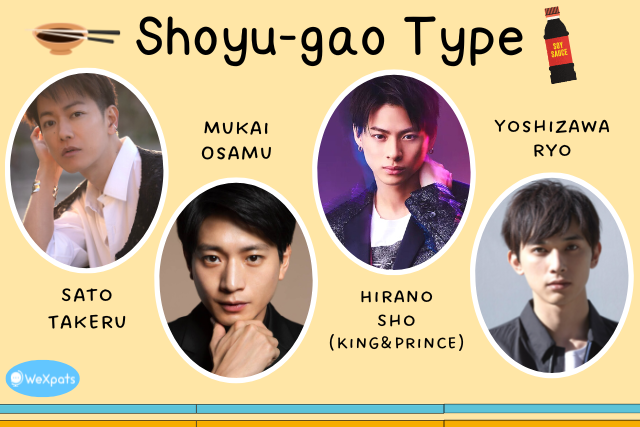
Shoyu means soy sauce.
Shoyu-gao is often meant to describe the “typical” Japanese ikemen.
They have clean cut facial features, stronger than shio-gao, but not as strong as the next type, sauce-gao. They’re usually not as pale as shio-gao.
Sato Takeru, known best for playing Kenshin in the live action Ruroni Kenshin series, is considered the ultimate shoyu-gao.
Other examples include Mukai Osamu, Hirano Sho (King & Prince), Yoshizawa Ryo, etc.
Sauce-gao Ikemen ソース顔
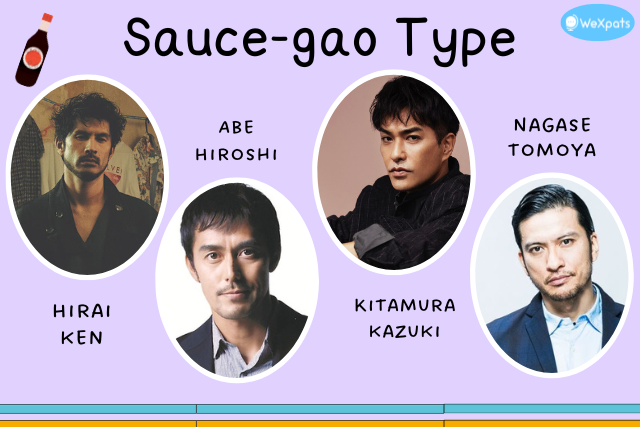
Sauce-gao means their facial features are very strong, and they tend to have darker skin tones (not always). Strong facial features include things like chiseled jaw, thick eyebrows, tall nose, high cheekbones, striking and deep-set eyes.
Singer Hirai Ken is often given as an example of the ultimate sauce-gao.
Other examples include Abe Hiroshi, Kitamura Kazuki, Nagase Tomoya, etc.
Satou-gao Ikemen 砂糖顔

Satou means sugar.
These are the sweet looking ikemen who have big eyes and small faces that tend to be rounder or less sharp (typically). They are often described as “cute” and “youthful”, including their mannerisms, regardless of age. In other words, having a “baby face” or 童顔 (dougan).
Actor Chiba Yudai is the ultimate satou-gao.
Others include Koike Teppei, Kamiki Ryunosuke, Iwata Takanori (Sandaime J Soul Brothers), etc.
And more…
The above 4 condiment face types are the most known types, but more recently, there have been additions to the list! Vinegar, mayonnaise, ketchup, miso…these fill in the gaps between the aforementioned categories for the people who could belong between two different ones, or don’t quite fit into any. However these new categories haven’t quite caught on as much as the older ones, so there’s many people in Japan that are surprised at these new categories and descriptions.
Writer's Pick
Ikemen vs Bishounen
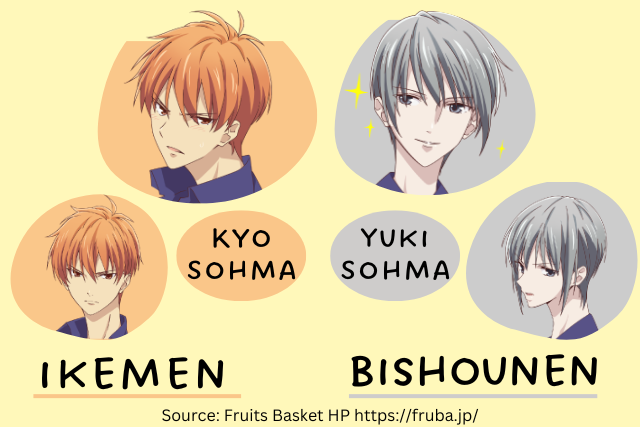
Then how about the other word you often hear, especially in shoujo manga and related media - bishounen?
Bishounen is written 美少年, bi meaning beautiful, shounen meaning young guy (12~20 years old).
Thus, while ikemen can cover all ranges of ages but tends to skew older, bishounen refers mainly to teens. Ikemen also includes “cool” guys, both in looks and mannerisms, whereas bishounen focuses on beautiful - in this case, softer and more delicate features.
Thus the image above is of the two lead male characters in Fruits Basket - Kyo who is considered ikemen, and Yuki who is considered bishounen.
There is the term 美男子 bidanshi to refer to refer to bishounen who is older than the age range - however this term is a little less used. Ikemen seems to have replaced the word and encompasses the meaning, even though bidanshi is a specific type of ikemen. This was perhaps propelled by both the Japanese name for the Korean drama “You’re Beautiful”and the Japanese remake of it being named “美男子ですね” which is written “Bidanshi desu ne” but is actually read “Ikemen desu ne”.
Side note: There’s a boyband in Japan named Bishounen so if you look the word up, they will probably be in the search results.
Ikemen Ranking in Japan 2022 & 2023
We will cover both Japanese celebrities and anime examples in this part.
Japanese Celebrities Ikemen Ranking 2022 & 2023
Every year Vivi (a fashion magazine) does a “National Treasure Level Ikemen Ranking” in the first half and second half of the year. The candidates are usually actors and singers.
It’s divided into 3 categories
-
Now
-
Next (under 22 yrs old)
-
Adult (30 yrs old and up)
There is a voting period open to the public after which the Vivi staff select the final ranking by how much buzz the candidates created during that 6 month period.
Once a person has won 1st place twice in a category, they are called 殿堂入り (dendouiri) or legendary status, removing them from being voted for in the future. Some that have achieved legendary status include Yamazaki Kento, Suda Masaki, Machida Keita and Matsumura Hokuto (SixTONES).
The results for 2022 & first half of 2023 are as follows:
Now Category:
First Half of 2022: Michieda Shunsuke (Naniwa Danshi)
Second half of 2022 and first half of 2023: Meguro Ren (Snow Man)
Next Category:
Second half of 2022: Suzuka Ouji (actor)
First half of 2023: Nagao Kento (Naniwa Danshi)
Adult Category:
First and second half of 2022: Yamada Yuki
First Half of 2023: Sakaguchi Kentaro (check out the video in the post)
Of course, these are just the most recent results. These are just some of the celebrities that our team answered when asked who they consider ikemen (excluding people mentioned earlier in the article).
Sugino Yosuke, Hirano Sho, Iwata Takanori, Nagase Ren, Kimura Takuya, Fukuyama Masaharu, HYDE, Oguri Shun, Takahashi Fumiya, Mitsuji Sen, Takenouchi Yutaka, Ichikawa Shinnosuke, Tsumabuki Satoshi, Odagiri Joe, Ando Masanobu, Kubota Yosuke, etc.
Anime Ikemen vs Bishounen Ranking
Defining ikemen in anime is a little harder because it also depends on the art style and taste. However, the public agrees that certain characters are incredibly attractive, summed up by ranking sites.
Note that these are not official rankings but rankings with lots of votes online.
While there’s no official or unofficial bishounen ranking for celebrities as far as we could find, we found an unofficial bishounen ranking for anime (as there are many, and the word is used more to describe manga and anime characters anyway in our experience).
We will compare the top 3 for each category.
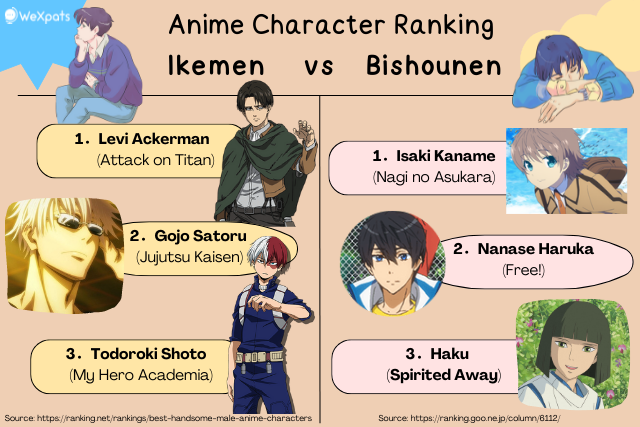
Ikemen Ranking Source, Bishounen Ranking Source
Ikemen Ranking
- Levi Ackerman (Attack on Titan)
- Gojo Satoru (Jujutsu Kaisen)
- Shoto Todoroki (My Hero Academia)
Bishounen Ranking
- Isaki Kaname (Nagi no Asukara)
- Nanase Haruka (Free!)
- Haku (Spirited Away)
These are just some of the characters that our team answered when asked who they consider ikemen.
Sakurazuka Seishiro (Tokyo Babylon), Ou Hon / Wang Ben (Kingdom), Saeba Ryo (City Hunter), Shiba Tatsuya (The Irregular at Magic High School), Kurosaki Ichigo (BLEACH), Sendou Akira (Slam Dunk), Kazehaya Shota (Kimi ni Todoke), Zoro (One Piece), Sebastian Michaelis (Black Butler) etc.
Other Ways to Compliment Men
There’s many other ways you can compliment men besides ikemen.
These include
-
ハンサム (hansamu) - handsome
-
かっこいい (kakkoii) - cool
-
男前 (otokomae) - handsome, stud, cool
-
ダンディー (dandy) - handsome & sophisticated man (usually used for older men)
-
スマート (smaato) - fashionable, gentlemanly
-
スタイルがいい (sutairu ga ii) - stylish, fashionable and fit
We hope this article was helpful to illustrate what ikemen is and how to use the word!








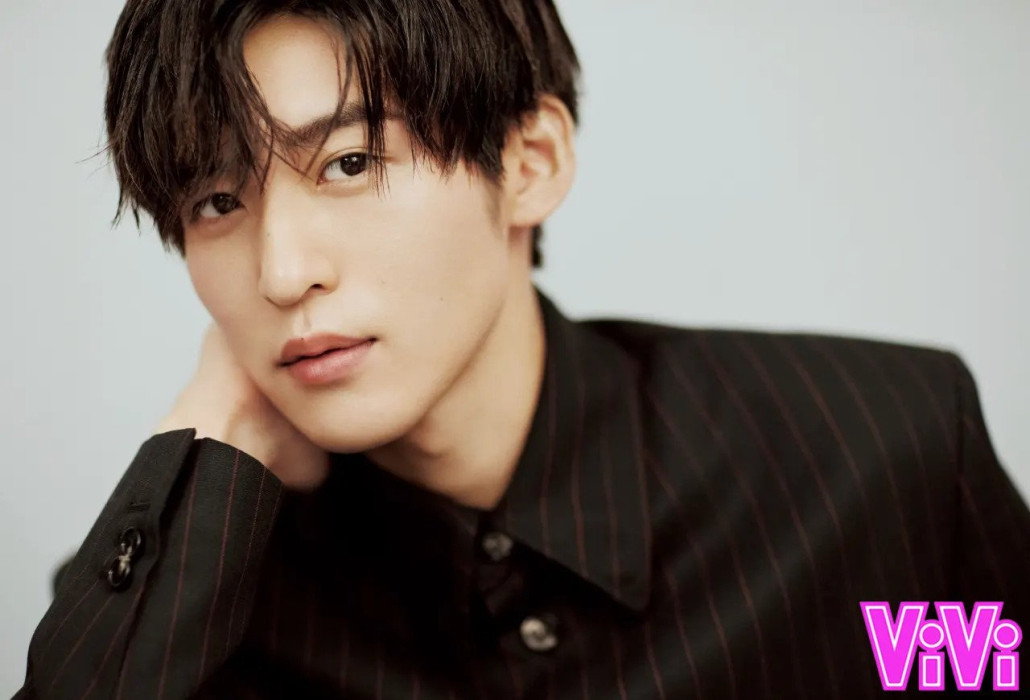



.png)
























